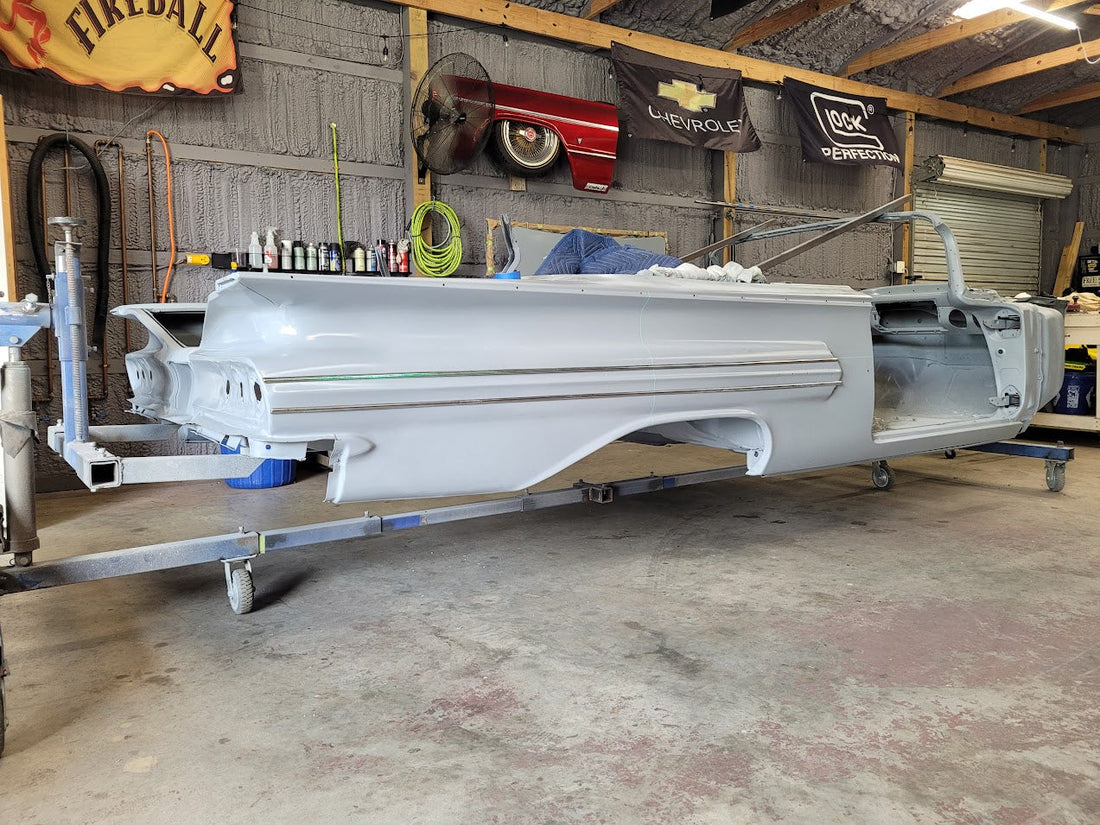
WHY ARE THERE SO MANY PRIMERS??? EACH PRODUCT HAS ITS PURPOSE!
Share
Let’s talk about the different types of primers used when painting or restoring your car
I remember when I was first introduced to the paint, body and restoration idea. I didn’t know the first thing about what primer to use or the benefits of each product. I spent a lot of time researching different products and learning what each one is used for. I am going to save you some time and give you the cliff notes. For discussion purposes, we will approach this topic as if you are starting with clean bare metal on your vehicle.
- Epoxy primer
Epoxy primers should be waterproof, or moisture proof. They should be oil resistant. They should be brake fluid resistant. They should be sand able. They should be affordable. If you have watched the YouTube channel, you know I am big fan of the SPI epoxy. I have been using it for about 10yrs now. It has all the bases covered. Epoxy primer is used as the first line of defense against corrosion on bare metal. The bare metal is usually sand blasted or sanded mechanically, or by hand with 80 grit. The metal should be clean of any oils, shavings, contaminants or debris before applying epoxy primer. I like to refer this of this type of primer as “sprayable glue” . It will bond mechanically and then cure chemically to create a barrier for the bare metal. It encases the bare metal and protects while the project either sits, or gets worked on. You do not want to use any other type of primer on bare metal. This should be the first step in your paint process. Depending on skill set, this can also be the only product used in the entire paint process, which in my opinion will result in the best outcome.
- Polyester Primer
Polyester primer is sometimes referred to as “sprayable bondo” In simple terms , all it is , is a very thick primer. It is moisture resistant. It is normally used when extensive body work, or filler/bondo work is done. Common brand names would be “Evercoat Featherfill G2”, “Evercoat Superbuild 4:1”, and “Slick Sand” All 3 of these serve the same purpose. To fill and level out panels that have had damage or filler work. The important thing to note when applying these products is that you have a small window of time, depending on ambient temperature. Only mix what you plan to spray, and spray it immediately after mixing. These products should be top coated with something before base coat. They are usually sanded with 80/180/220 grit. They will have a hard “egg shell” type of appearance and could be difficult to sand initially, until you crack open that shell. The phrase “crack open” is not to be taken literally. It means sand the outer layer of the material. This product should not be abused. It should not be used to fill big dents and you should not be spraying gallons and gallons of it on your car. It has its limitations. When applying these products, stay away from jams, edges and lips of panels. If you apply too thick or too much, it will fail and crack eventually. It is very brittle when it is abused or misused.
- Urethane Primer
Usually referred to as “2k primer” or “2k high build” These primers are used to fill minor imperfections. They will not fill dents. They are used as a surfacer before sealer, or basecoat. Thickness varies depending on manufacturer, however they should not be misused. 2-3 coats prior to sanding is all you should need. If you need to apply more than that, then you should probably revisit the body work stage of your project. These primers are usually sanded with 180/220/320/400 or 600 grit paper, depending on application. Urethane primers are porous. They are not water proof. They should not be used over bare metal. Minor imperfections only. Urethane primer is often misunderstood as an “all in one”. It can be use as that, but your work will most likely fail in the future.
- Primer Sealer
This primer is used prior to spraying color. The last step in the priming process. I prefer using reduced epoxy primer as my primer sealer of choice, however 2k primer sealers are used everyday in the industry. This product should require no sanding when applied. You should be able to spray it, give it proper flash time, and go straight to color, without sanding anything. A little secret is, they are usually just 2k urethane primers that are reduced with urethane reducer. I prefer epoxy as a sealer because of its adhesive properties, remember what I said about sprayable glue?....
Lets talk about a big misconception with products labeled DTM. DTM means “direct to metal”. DTM primers should not be mistaken for epoxy primers. Just because a product can be applied to bare metal, doesn’t mean is should be applied to bare metal. Epoxy primer should always be used over bare metal in a restoration process. Why? Because it is water proof. DTM primers are not all water proof. DTM is used by marketing teams to sell products. They want to convince the consumer than you only need 1 product.
With all this being said, do you need all of these primers for your project? The short answer is NO. The long answer is, it depends on the condition of your project. In my opinion, “epoxy only” is the best way to go. It would be the most ideal scenario, it is also the most difficult to achieve. My personal approach to a project would be 1. Epoxy. 2. Body work 3. Polyester if needed. 4. Epoxy sealer.
Leave a comment and let me know what topics you would like to cover next!



